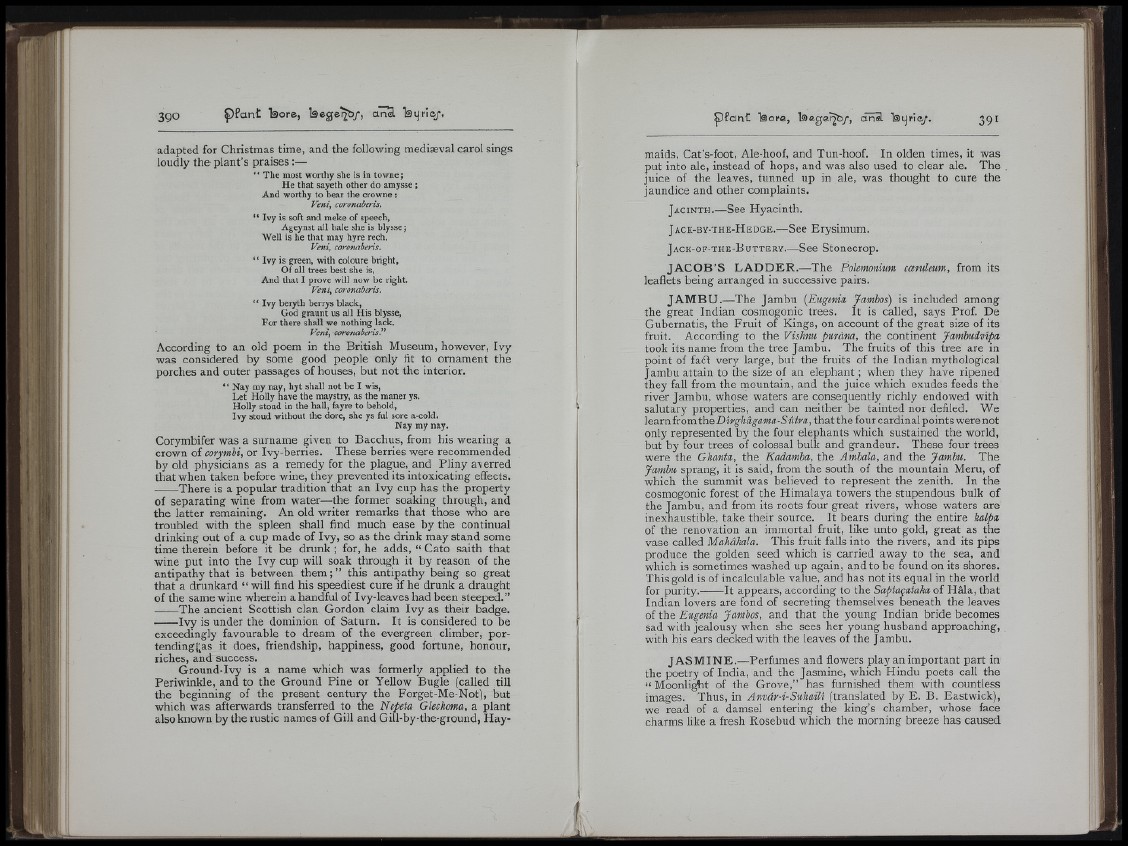
r
!
4.!
î r ’ i
i I
i'/ ï. , V:
V i
t h i."
l i
¥
adapted for Christmas time, and the following mediæval carol sings
loudly the plant’s praises :—
“ The most worthy she is in towne;
He that sayeth other do amysse ;
And worthy to bear the crowne :
Vmi, coronaberis.
“ Ivy is soft and meke of speech,
Ageynst all bale she is blysse;
Well is he that may hyre rech.
Veni, coronabez'is.
“ Ivy is green, with coloure bright,
Of all trees best she is,
And that I prove will now be right.
Veni, coronaberis.
“ Ivy beryth berrys black,
God graunt us all His blysse,
For there shall we nothing lack.
Vezti, coronaberis!
According to an old poem in the British Museum, however. Ivy
was considered by some good people only fit to ornament the
porches and outer passages of houses, but not the interior.
“ Nay my nay, hyt shall not be I wis,
Let Holly have the maystry, as the maner ys.
Holly stoud in the hall, fayre to behold,
Ivy stoud without the dore, she ys ful sore a-cold.
Nay my nay.
Corymbifer was a surname given to Bacchus, from his wearing a
crown of covymbi, or Ivy-berries. These berries were recommended
by old physicians as a remedy for the plague, and Pliny averred
that when taken before wine, they prevented its intoxicating effects.
There is a popular tradition that an Iv y cup has the property
of separating wine from water—the former soaking through, and
the latter remaining. An old writer remarks that those who are
troubled with the spleen shall find much ease by the continual
drinking out of a cup made of Ivy, so as the drink may stand some
time therein before it be drunk ; for, he adds, “ Cato saith that
wine put into the Iv y cup will soak through it by reason of the
antipathy that is between them ; ” this antipathy being so great
that a drunkard “ will find his speediest cure if he drunk a draught
of the same wine wherein a handful of Ivy-leaves had been steeped.”
The ancient Scottish clan Gordon claim Iv y as their badge.
Iv y is under the dominion of Saturn. It is considered to be
exceedingly favourable to dream of the evergreen climber, por-
tendingljas it does, friendship, happiness, good fortune, honour,
riches, and success.
Ground-Ivy is a name which was formerly applied to the
Periwinkle, and to the Ground Pine or Yellow Bugle (called till
the beginning of the present century the Forget-Me-Not), but
which was afterwards transferred to the Nepeta Glechoma, a plant
also known by the rustic names of Gill and Gill-by-the-ground, Hay-
I
maids, Cat’s-foot, Ale-hoof, and Tun-hoof. In olden times, it was
put into ale, instead of hops, and was also used to clear ale. The
juice of the leaves, tunned up in ale, was thought to cure the
jaundice and other complaints.
Ja c in th .—See Hyacinth.
J ack-by-the-Hedge.—See Frysimum.
Ja c k -o f - th e -B u t t e r y .—See Stonecrop.
JA C O B ’ S L A D D E R . - -The Polemonium cceruleum, from its
leafiets being arranged in successive pairs,
JA M B U . - -The Jambu {Eugenia Jambos) is included among
the great Indian cosmogonic trees. It is called, says Prof. De
Gubernatis, the Fruit of Kings, on account of the great size of its
fruit. According to the Vishnu purdna, the continent Jambudvipa
took its name from the tree Jambu. The fruits of this tree are in
point of facff very large, but the fruits of the Indian mythological
Jambu attain to the size of an elephant; when they have ripened
they fall from the mountain, and the juice which exudes feeds the
river Jambu, whose waters are consequently richly endowed with
salutary properties, and can neither be tainted nor defiled. We
learn from the Dirghdgama-Sdtra, that the four cardinal points were not
only represented by the four elephants which sustained the world,
but by four trees of colossal bulk and grandeur. These four trees
were the Ghanta, the Kadamba, the Ambala, and the Jambu. The
Jambu sprang, it is said, from the south of the mountain Meru, of
which the summit was believed to represent the zenith. In the
cosmogonic forest of the Himalaya towers the stupendous bulk of
the Jambu, and from its roots four great rivers, whose waters are
inexhaustible, take their source. It bears during the entire kalpa
of the renovation an immortal fruit, like unto gold, great as the
vase called Mahdhala. This fruit falls into the rivers, and its pips
produce the golden seed which is carried away to the sea, and
which is sometimes washed up again, and to be found on its shores.
This gold is of incalculable value, and has not its equal in the world
for purity. It appears, according to the Saptagataka of Hala, that
Indian lovers are fond of secreting themselves beneath the leaves
of the Eugenia Jambos, and that the young Indian bride becomes
sad with jealousy when she sees her young husband approaching,
with his ears decked with the leaves of the Jambu.
JA S M IN E .—Perfumes and fiowers play an important part in
the poetry of India, and the Jasmine, which Hindu poets call the
“ Moonlig+t of the Grove,” has furnished them with countless
images. Thus, in Anvdr-i-Suhaili (translated by F . B. Eastwick),
we read of a damsel entering the king’s chamber, whose face
charms like a fresh Rosebud which the morning breeze has caused